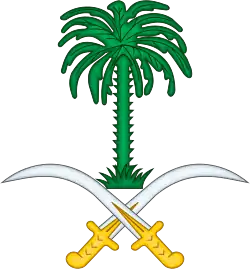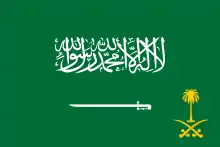Faisal of Saudi Arabia
Faisal bin Abdulaziz Al Saud (Arabic: فيصل بن عبدالعزيز آل سعود Fayṣal ibn ‘Abd al-‘Azīz Āl Su‘ūd; 14 April 1906 – 25 March 1975) was King of Saudi Arabia and Custodian of the Two Holy Mosques from 2 November 1964 to 25 March 1975.
| Faisal | |||||
|---|---|---|---|---|---|
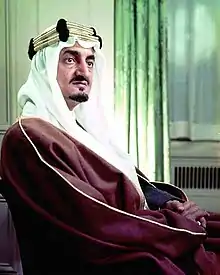 | |||||
| King of Saudi Arabia Custodian of the Two Holy Mosques | |||||
| Reign | 2 November 1964 – 25 March 1975 | ||||
| Bay'ah | 2 November 1964 | ||||
| Predecessor | Saud | ||||
| Successor | Khalid | ||||
| Regent of Saudi Arabia | |||||
| Tenure | 4 March 1964 – 2 November 1964 | ||||
| Monarch | Saud | ||||
| Prime Minister of Saudi Arabia | |||||
| Tenure | 1962 – 25 March 1975 | ||||
| Predecessor | Saud | ||||
| Successor | Khalid | ||||
| Tenure | 16 August 1954 – 21 December 1960 | ||||
| Predecessor | Saud | ||||
| Successor | Saud | ||||
| Minister of Foreign Affairs | |||||
| Tenure | 19 December 1930 – 22 December 1960 | ||||
| Predecessor | Office created | ||||
| Successor | Ibrahim bin Abdullah Al Suwaiyel | ||||
| Monarch | Abdulaziz Saud | ||||
| Tenure | 16 March 1962 – 25 March 1975 | ||||
| Predecessor | Ibrahim bin Abdullah Al Suwaiyel | ||||
| Successor | Saud Al Faisal | ||||
| Monarch | Saud Himself | ||||
| Born | 14 April 1906 Riyadh, Emirate of Riyadh | ||||
| Died | 25 March 1975 (aged 68) Riyadh, Saudi Arabia | ||||
| Burial | 26 March 1975 Al-Oud cemetery, Riyadh | ||||
| Spouses | Many (see #Personal life) | ||||
| Issue Detail | Numerous | ||||
| |||||
| House | House of Saud | ||||
| Father | King Abdulaziz | ||||
| Mother | Tarfa bint Abdullah Al Sheikh | ||||
Faisal was the third son of King Abdulaziz.[note 1] His mother, Tarfa, was a member of the Al ash-Sheikh family which has produced many prominent Saudi religious leaders. Faisal emerged as an influential royal politician under his father and brother, King Saud. He was the Saudi foreign minister from 1930 and prime minister from 1954 until his death, except for a two-year break (1960–1962) in both positions. Faisal was crown prince of Saudi Arabia after Saud's accession in 1953, and in that position he outlawed slavery in Saudi Arabia. He persuaded King Saud to abdicate in his favour in 1964 with the help of other members of the royal family and his relative, Grand Mufti Muhammad ibn Ibrahim Al ash-Sheikh.
Faisal implemented a policy of modernization and reform. His main foreign policy themes were pan-Islamism, anti-communism,[1][note 2] and pro-Palestinianism.[2] He attempted to limit the power of Islamic religious officials. Protesting against support that Israel received from the West, he led the oil embargo which caused the 1973 oil crisis. Faisal successfully stabilized the kingdom's bureaucracy, and his reign had significant popularity among Saudi Arabians despite his reforms facing some controversy. In 1975, he was assassinated by his nephew Faisal bin Musaid.
Early life and education

Faisal bin Abdulaziz was born in Riyadh on 14 April 1906.[3][4][5] He was the third son of King Abdulaziz and the first of his sons who was born in Riyadh.[6][7] His mother was Tarfa bint Abdullah bin Abdullatif Al Sheikh,[8] whom Abdulaziz had married in 1902 after capturing Riyadh. She was from the Al ash-Sheikh family, descendants of Muhammad ibn Abd al-Wahhab.[9] Faisal's maternal grandfather, Abdullah bin Abdullatif, was one of Abdulaziz's principal religious teachers and advisers.[10][11] Faisal's mother died in 1906 when he was six months old.[10] Following this Faisal began to live with his maternal grandparents, Abdullah bin Abdullatif and Haya bint Abdul Rahman Al Muqbel,[12] and Abdullah educated his grandson.[10] Faisal had only one full sister, Noura. She married her cousin, Khalid bin Muhammad bin Abdul Rahman.[13]
According to Helen Chapin Metz, Faisal, and most of his generation, was raised in an atmosphere in which courage was extremely valued and reinforced.[14] From 1916 he was tutored by Hafiz Wahba who later served in various governmental posts.[15]
In 1919 the British government invited King Abdulaziz to visit London.[16] He could not go, but Prince Turki, the eldest son of Abdulaziz, was assigned as the envoy of his father.[16] However, Prince Turki died due to Spanish flu before the visit.[16] Therefore, Prince Faisal was sent to London instead, making him the first ever Saudi Arabian royal to visit England.[16] His visit lasted for five months, and he met with British officials.[17] During the same period, he also visited France, again being the first Saudi Arabian royal to pay an official visit there.[18]
Early political experience
.jpg.webp)
As one of King Abdulaziz's eldest sons, Prince Faisal was given numerous responsibilities to consolidate control over Arabia. After the capture of Hail and initial control over Asir in 1922, he was sent to these provinces with nearly six thousand fighters. He achieved complete control over Asir at the end of the year.[19] Prince Faisal was appointed viceroy of Hejaz in 1926 following his father's takeover of the region.[20] He often consulted with local leaders during his tenure.[21] In addition, Prince Faisal was the president of the consultative assembly and the minister of interior.[22]
In December 1931 following the announcement of the constitution of the council of deputies (Majlis al Wukala) he became the president of the four-member council and minister of foreign affairs, and continued to hold his previous titles, viceroy of Hejaz, the president of the consultative assembly and the minister of interior.[22] He would continue to oversee Saudi foreign policy until his death—even as king, with only a two-year break[23] between 1960 and 1962.[20]
Faisal visited several countries in this period, including Iran in May 1932,[24] Poland in 1932 and Russia (as part of the USSR) in 1933.[25][26] He commanded a campaign during the Saudi–Yemeni War in 1934, resulting in a Saudi victory.[20]
Following the invitation of President Roosevelt Faisal and his half-brother Prince Khalid visited the US in October 1943.[27] Given that they both became the kings later their visit is one of the early contacts between Saudi Arabia and the USA.[27]
Crown prince and prime minister
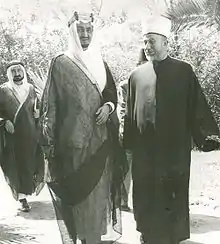
Upon the accession of Prince Faisal's elder brother, King Saud, to the throne in 1953, Faisal was appointed crown prince. On 16 August 1954 he was made prime minister.[28]
King Saud embarked on a spending program that included the construction of a massive royal residence on the outskirts of the capital, Riyadh. He also faced pressure from neighboring Egypt, where Gamal Abdel Nasser had overthrown the monarchy in 1952. Nasser was able to cultivate a group of dissident princes led by Prince Talal bin Abdulaziz, who defected to Egypt (see Free Princes). Fearing that King Saud's financial policies were bringing the state to the brink of collapse, and that his handling of foreign affairs was inept, senior members of the royal family and the ulema (religious leadership) pressured Saud into appointing Faisal to the position of prime minister in 1958, giving Faisal wide executive powers.[29]
A power struggle ensued between King Saud and Crown Prince Faisal, and on 18 December 1960, Crown Prince Faisal resigned as prime minister in protest, arguing that King Saud was frustrating his financial reforms. King Saud took back his executive powers and, having induced Prince Talal to return from Egypt, appointed him as minister of finance in July 1958.[30][31] In 1962, however, Crown Prince Faisal rallied enough support within the royal family to install himself as prime minister for a second time.[29] Less than a month before this event Crown Prince Faisal and US President John F. Kennedy held a secret meeting in Washington DC on 4 October 1962.[32][33]
In 1963 Crown Prince Faisal established the country's first television station, though actual broadcasts would not begin for another two years.[34] Crown Prince Faisal helped establish the Islamic University of Madinah in 1961. In 1962 he helped found the Muslim World League, a worldwide charity to which the Saudi royal family has reportedly since donated more than a billion dollars.[35]
Struggle with King Saud

The struggle with King Saud continued in the background during this time. Taking advantage of the king's absence from the country for medical reasons in early 1963, Faisal began amassing more power for himself. He removed many of Saud's loyalists from their posts and appointed like-minded princes in key military and security positions,[36][37] such as his brother Prince Abdullah, to whom he gave command of the National Guard in 1962. Upon King Saud's return, Crown Prince Faisal demanded that he be made regent and that King Saud be reduced to a purely ceremonial role. In this, he had the crucial backing of the ulema (elite Islamic scholars), including a fatwā (edict) issued by the grand mufti of Saudi Arabia, a relative of Crown Prince Faisal on his mother's side, calling on King Saud to accede to his brother's demands.[38]
King Saud refused, however, and made a last-ditch attempt to retake executive powers, leading Crown Prince Faisal to order the National Guard to surround King Saud's palace. His loyalists outnumbered and outgunned, King Saud relented, and on 4 March 1964, Crown Prince Faisal was appointed regent. A meeting of the elders of the royal family and the ulema was convened later that year, and a second fatwā was decreed by the grand mufti, calling on King Saud to abdicate the throne in favor of his brother. The royal family supported the fatwā and immediately informed King Saud of their decision. King Saud, by now shorn of all his powers, agreed, and Faisal was proclaimed king on 2 November 1964.[29][37] Saud then went into exile, finding refuge in Egypt before eventually settling in Greece.[39]
King of Saudi Arabia
In a speech shortly after he came to power on 2 November 1964, Faisal said:
I beg of you, brothers, to look upon me as both brother and servant. 'Majesty' is reserved to God alone and 'the throne' is the throne of the Heavens and Earth.[40]
One of the earliest actions Faisal took as king was to establish a council to deal with future succession issues.[41] The members were two of his uncles, Prince Abdullah and Prince Musaid, and five of his half-brothers, Crown Prince Khalid, Prince Fahd, Prince Abdullah, Prince Sultan and Prince Nawwaf.[41] In 1967 King Faisal established the post of second prime minister and appointed Prince Fahd to this post.[42] The reason for this newly established body was Crown Prince Khalid's request and suggestion.[43] The most senior adviser of King Faisal during his reign was Rashad Pharaon who was his father's private physician.[44] Another one was Mohammad ibn Ibrahim Al Sheikh who was influential in shaping his political role in the Arab world.[45]
Modernization
Early in his rule, King Faisal issued an edict that all Saudi princes had to school their children inside the country, rather than sending them abroad; this had the effect of making it popular for upper-class families to bring their sons back to study in the Kingdom.[46] King Faisal also introduced the country's current system of administrative regions, and laid the foundations for a modern welfare system. In 1970 he established the Ministry of Justice and inaugurated the country's first "five-year plan" for economic development.[47]
One of his modernization attempts was the new laws on media, publishing, and archiving and bilateral cultural cooperation protocols with foreign and corporate archives that kept records about mid-twentieth century Arabia.[32] Television broadcasts officially began in 1965. In 1966 a nephew of Faisal attacked the newly established headquarters of Saudi television but was killed by security personnel. The attacker was the brother of Faisal's future assassin, and the incident is the most widely accepted motive for the murder.[48]
Steps against coups d'état
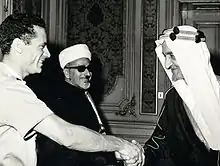
The 1950s and 1960s saw numerous coups d'état in the region. Muammar al-Gaddafi's coup that overthrew the monarchy in oil-rich Libya in 1969 was especially threatening for Saudi Arabia due to the similarity between the two sparsely-populated desert countries.[49] As a result, King Faisal undertook to build a sophisticated security apparatus and cracked down firmly on dissent. As in all affairs, King Faisal justified these policies in Islamic terms. Early in his reign, when faced with demands for a written constitution for the country, King Faisal responded that "our constitution is the Quran".[50] In the summer of 1969 King Faisal ordered the arrest of hundreds of military officers, including some generals,[51] alleging that a military coup d'état was being planned. The coup was planned primarily by air force officers and aimed at overthrowing the monarchy and founding a Nasserist regime in the country.[52] The arrests were possibly based on a tip from American intelligence.[49]
Religious inclusiveness
King Faisal seemed to hold the pluralist view, favouring limited, cautious accommodation of popular demands for inclusive reform, and made repeated attempts to broaden political representation, harking back to his temporarily successful national integration policy from 1965 to 1975. King Faisal acknowledged his country's religious and cultural diversity, which includes the predominantly Shia Al Ahsa in the east; the Asir in the southwest, with tribal affinities to Yemen, especially among the Ismaili tribes of Najran and Jizan; and the Kingdom of the Hejaz, with its capital Mecca. He included non-Wahhabi, cosmopolitan Sunni Hejazis from Mecca and Jeddah in the Saudi government. However, after his reign, discrimination based on sect, tribe, region, and gender became the order of the day and has remained as such until today.[53]
The role and authority of the ulema declined after the rise of King Faisal even though they had helped bring him to the throne in 1964. Despite his piety and biological relationship through his mother to the Al as Shaykh family, and his support for the pan-Islamic movement in his struggle against pan-Arabism, he decreased the ulema's power and influence.[54] Unlike his successor King Khalid, King Faisal attempted to prevent radical clerics from controlling religious institutions such as the Council of Senior Ulema, the highest religious institution in Saudi Arabia, or taking religious offices such as Grand Mufti, responsible for preserving Islamic law. But his advisers warned that, once religious zealots had been motivated, disastrous effects would result.[35] King Faisal rejected the ulema's opposition to aspects of his accelerated modernization attempts, sometimes even in matters considered by them to be major issues[54] such as education for women.[55]
Corruption in the royal family was taken very seriously by religious figures in the Islamic theological colleges. They challenged some of the accepted theological interpretations adopted by the Saudi regime. One such influential figure was Shaykh bin Baz, then rector of the Al Medina college of theology. King Faisal would not tolerate his criticism and had him removed from his position. However, his teachings had already radicalized some of his students. One of them was Juhayman al-Otaybi.[56]
Abolition of slavery
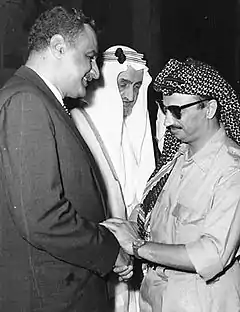
Slavery did not vanish in Saudi Arabia until King Faisal issued a decree for its total abolition in 1962. BBC presenter Peter Hobday stated that about 1,682 slaves were freed at that time, at a cost to the government of $2,000 each.[56] The political analyst Bruce Riedel argued that the US began to raise the issue of slavery after the meeting between King Abdulaziz and US president Franklin D. Roosevelt in 1945 and that John F. Kennedy finally persuaded the House of Saud to abolish slavery in 1962.[57]
Foreign relations

As king, Faisal continued the close alliance with the United States begun by his father, and relied on the US heavily for arming and training his armed forces. King Faisal was anti-communist. He refused any political ties with the Soviet Union and other Communist bloc countries, professing to see a complete incompatibility between communism and Islam.[58] King Faisal's first official visit to the US was in June 1966.[27]
Between 23 and 25 September 1969, King Faisal convened a conference in Rabat, Morocco, to discuss the arson attack on the Al Aqsa Mosque that had occurred a month earlier. The leaders of 25 Muslim states attended and the conference called for Israel to give up territory conquered in 1967. The conference also set up the Organisation of Islamic Cooperation and pledged its support for the Palestinians.[59]
Following the death of Nasser in 1970, King Faisal drew closer to Egypt's new president, Anwar Sadat, who himself was planning a break with the Soviet Union and a move towards the pro-American camp. During the 1973 Arab–Israeli War, launched by Sadat, King Faisal withdrew Saudi oil from world markets, in protest over Western support for Israel during the conflict. This action increased the price of oil and was the primary force behind the 1973 oil crisis. It was to be the defining act of King Faisal's career, and gained him lasting prestige among many Arabs and Muslims worldwide. In 1974 he was named Time magazine's Man of the Year, and the financial windfall generated by the crisis fueled the economic boom that occurred in Saudi Arabia after his death. The new oil revenue also allowed Faisal to greatly increase the aid and subsidies begun following the 1967 Six-Day War[2] to Egypt, Syria, and the Palestine Liberation Organization.[60] It is a commonly-held belief in Saudi Arabia, and the wider Arab world, that King Faisal's oil embargo was the real cause of his assassination, via a Western conspiracy.[61][62]
Personal life
King Faisal married many times concurrently.[12] His spouses were from powerful families: Al Kabir, Al Sudairi, Al Jiluwi and Al Thunayan.[63] His wives were:
- Sultana bint Ahmed Al Sudairi, the mother of his eldest son Prince Abdullah, whom Faisal fathered when he was only fifteen. Sultana was from the Sudairi family and the younger sister of Hassa bint Ahmed, the mother of the Sudairi brothers.[64]
- Iffat Al-Thunayan (1916–2000), who was born and raised in Turkey. Her ancestors of the Al Thunayan branch of the Al Saud family.[65] They first met in Istanbul around 1932 while he was in Turkey for an official visit.[17][66] They had nine children,[65] including Prince Mohammed, Prince Saud, and Prince Turki.[67] Iffat was credited with being the influence behind many of her husband's reforms, particularly with regard to women.[68][69] Faisal also raised Iffat's younger brother, Kamal Adham.[70] King Faisal later appointed Kamal as the first president of the Saudi intelligence agency Al Mukhabarat Al A'amah.[71] He was also an advisor to his royal brother-in-law.[72]
- Al Jawhara bint Saud Al Kabir bin Abdulaziz Al Saud, the daughter of his aunt Nuora bint Abdul Rahman and Saud Al Kabir.[73] They married in October 1935. With Al Jawhara, Faisal had one daughter, Mashail (died October 2011).[12]
- Haya bint Turki bin Abdulaziz Al Turki, the mother of Princess Noura, Prince Saad and Prince Khalid.[74] She was a member of the Al Jiluwi clan.[8][75]
- Hessa bint Muhammad bin Abdullah Al Muhanna Aba Al Khail, the mother of Princess Al Anoud (died June 2011) and Princess Al Jawhara (died April 2014).[12]
- Munira bint Suhaim bin Hitimi Al Thanayan Al Mahasher, the mother of Princess Hessa,[12] who died in December 2020.[76]
- Fatima bint Abdulaziz bin Mushait, the mother of Princess Munira (died young).[12]
Faisal's sons were all educated abroad.[77] Prince Turki received formal education at prestigious schools in New Jersey, and he later attended Georgetown University,[78] while Prince Saud was an alumnus of Princeton University. King Faisal's sons have held, and continue to hold, important positions in the Saudi government. His eldest son, Prince Abdullah, held governmental positions for a while. Prince Khalid was the governor of Asir Province in southwestern Saudi Arabia for more than three decades before becoming governor of Makkah Province in 2007. Prince Saud was the Saudi foreign minister between 1975 and 2015. Prince Turki served as head of Saudi Intelligence, ambassador to the United Kingdom, and later ambassador to the United States.[79] Prince Abdul Rahman who was a graduate of Sandhurst Military Academy died in March 2014. Prince Mohammed was a businessman who died in 2017. Prince Saad died in April 2017.[80]
King Faisal's daughter Haifa is married to Bandar bin Sultan. By giving Haifa's hand in marriage to Prince Bandar, King Faisal forced Bandar's father Prince Sultan to recognize Bandar as a legitimate prince. Another daughter, Lolowah, is a prominent activist for women's education in Saudi Arabia. In 1962 his daughter Princess Sara founded one of the first charitable organizations, Al Nahda, which won the first Chaillot prize for human rights organisations in the Gulf in 2009.[81] Her spouse was Muhammed bin Saud, who was one of King Saud's sons. One of his daughters, Princess Mishail, died at the age of 72 in October 2011.[82] His granddaughter, Princess Reem Al Faisal who is the daughter of Prince Mohammed, is a photographer and gallery owner based in Jeddah.[83][84]
King Faisal spoke fluent English and French,[85] as does his daughter Princess Lolowah.[86]
Assassination
On 25 March 1975 King Faisal was shot point-blank and killed by his half-brother's son, Faisal bin Musaid, who had just come back from the United States. The murder occurred at a majlis (literally 'a place for sitting'), an event where the king or leader opens up his residence to the citizens to enter and petition the king.[87]
In the waiting room, Prince Faisal talked to Kuwaiti representatives who were also waiting to meet King Faisal. When the Prince went to embrace him, King Faisal leaned to kiss his nephew in accordance with Saudi custom. At that instant, Prince Faisal took out a pistol and shot him. The first shot hit King Faisal's chin and the second one went through his ear. A bodyguard hit Prince Faisal with a sheathed sword. Oil minister Zaki Yamani yelled repeatedly not to kill the prince.[88]
King Faisal was quickly taken to a hospital. He was still alive as doctors massaged his heart and gave him a blood transfusion. Their efforts were unsuccessful, and King Faisal died shortly afterward. Both before and after the attack the prince was reported to be calm. Following the killing, Riyadh had three days of mourning during which all government activities were suspended.[88]
One theory for the murder was avenging the death of Prince Khalid bin Musaid, the brother of Prince Faisal bin Musaid. King Faisal instituted modern and secular reforms that led to the installation of television, which provoked violent protests, one of which was led by Prince Khalid, who, during the course of an attack on a television station in 1966, was shot dead by a policeman.[89]
Prince Faisal, who was captured directly after the attack, was at first officially declared insane, but following the trial a panel of Saudi medical experts decided that he was sane when he shot the king. The nation's high religious court convicted him of regicide and sentenced him to execution. He was beheaded in the public square in Riyadh.[88]
King Faisal's body was buried in Al Oud cemetery in Riyadh on 26 March 1975.[90][91] His successor, King Khalid, wept over his body at his funeral.[92]
Memorials and legacy
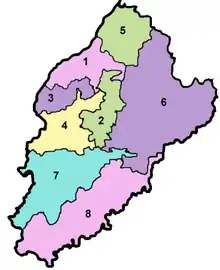
After his death, the King Faisal Foundation, a philanthropic organisation, was established in King Faisal's honour.[93] King Faisal was eulogized by lyricist Robert Hunter in the title track of the Grateful Dead's 1975 album Blues for Allah.[94]
Following the reign of King Faisal Gerald de Gaury published a biography of him entitled Faisal: King of Saudi Arabia.[95] In 2013 Russian Arabist Alexei Vassiliev published another biography, King Faisal of Saudi Arabia: Personality, Faith and Times.[1] A movie directed by Agustí Villaronga in 2019 entitled Born a King is about the visit of King Faisal to London in 1919 when he was fourteen years old.[96]
In October 1976 King Khalid initiated the construction of Faisal Mosque in Islamabad, Pakistan.[97] Lyallpur, the third largest city of Pakistan, was renamed Faisalabad (literally, "City of Faisal") in 1979 in his honor.[98][99] One of the two major Pakistan Air Force bases in Pakistan's Sindh province's largest city, Karachi, is named "PAF Base Faisal" in honour of King Faisal.[99][100]
Honors
During his visit to Taiwan in 1971 King Faisal was awarded by President Chiang Kai-shek the Order of Brilliant Jade with Grand Cordon.[101]
Ancestry
| Ancestors of Faisal of Saudi Arabia | |||||||||||||||||||||||||||||||||||||||||||||||||||||||||||||||||||||||||||||||||||||||||||||||||||||||||||||||||||||||||||||||||||||||||||||||||||||||||||||||||||||||||||||||||||||||||||||||||||||||||||||||||||||||||||||||||||||||||||||||||||||||||||||||||||||||||
|---|---|---|---|---|---|---|---|---|---|---|---|---|---|---|---|---|---|---|---|---|---|---|---|---|---|---|---|---|---|---|---|---|---|---|---|---|---|---|---|---|---|---|---|---|---|---|---|---|---|---|---|---|---|---|---|---|---|---|---|---|---|---|---|---|---|---|---|---|---|---|---|---|---|---|---|---|---|---|---|---|---|---|---|---|---|---|---|---|---|---|---|---|---|---|---|---|---|---|---|---|---|---|---|---|---|---|---|---|---|---|---|---|---|---|---|---|---|---|---|---|---|---|---|---|---|---|---|---|---|---|---|---|---|---|---|---|---|---|---|---|---|---|---|---|---|---|---|---|---|---|---|---|---|---|---|---|---|---|---|---|---|---|---|---|---|---|---|---|---|---|---|---|---|---|---|---|---|---|---|---|---|---|---|---|---|---|---|---|---|---|---|---|---|---|---|---|---|---|---|---|---|---|---|---|---|---|---|---|---|---|---|---|---|---|---|---|---|---|---|---|---|---|---|---|---|---|---|---|---|---|---|---|---|---|---|---|---|---|---|---|---|---|---|---|---|---|---|---|---|---|---|---|---|---|---|---|---|---|---|---|---|---|---|---|---|
| |||||||||||||||||||||||||||||||||||||||||||||||||||||||||||||||||||||||||||||||||||||||||||||||||||||||||||||||||||||||||||||||||||||||||||||||||||||||||||||||||||||||||||||||||||||||||||||||||||||||||||||||||||||||||||||||||||||||||||||||||||||||||||||||||||||||||
Notes
- The eldest son, Prince Turki of Nejd, and the second son, the eventual King Saud, were both children of Wadhah bint Muhammad bin 'Aqab.
- The king associated Communism with Zionism, which he also opposed.[1]
References
- "Unexpectedly modern". The Economist. 26 January 2013. Retrieved 17 July 2013.
- "King Faisal: Oil, Wealth and Power" Archived 26 August 2013 at the Wayback Machine, TIME Magazine, 7 April 1975.
- "King Faisal Ibn Abdul Aziz Al Saud, Saudi Arabia". Retrieved 25 June 2012.
- George Kheirallah (1952). Arabia Reborn. Albuquerque: University of New Mexico Press. p. 254. Archived from the original on 10 June 2019. Retrieved 14 March 2015. – via Questia (subscription required)
- "The kings of the Kingdom". Ministry of Commerce and Industry. Archived from the original on 22 October 2012. Retrieved 28 July 2012.
- Nabil Mouline (April–June 2012). "Power and generational transition in Saudi Arabia" (PDF). Critique Internationale. 46: 1–22.
- Paul L. Montgomery (26 March 1975). "Rise of a Desert Chief's Son to the World Power and Riches". Rutland Daily Herald. Times News Service. p. 2i. Retrieved 27 September 2020.
- Winberg Chai (22 September 2005). Saudi Arabia: A Modern Reader. University Press of America. p. 193. ISBN 978-0-88093-859-4. Archived from the original on 25 December 2018.
- "Wahhabism – A Unifier or a Divisive Element". APS Diplomat News Service. 7 January 2013. Archived from the original on 16 January 2020. Retrieved 26 March 2013.
- Alexander Bligh (1985). "The Saudi religious elite (Ulama) as participant in the political system of the kingdom". International Journal of Middle East Studies. 17: 37–50. doi:10.1017/S0020743800028750.
- "Riyadh. The capital of monotheism" (PDF). Business and Finance Group. Archived from the original (PDF) on 14 October 2009.
- "في ذكري ميلاده.. تعرف على أهم أسرار حياة الملك فيصل آل سعود". Elzman News (in Arabic). 14 April 2020. Retrieved 12 September 2020.
- As'ad AbuKhalil (2004). The Battle for Saudi Arabia. Royalty, fundamentalism and global power. New York City: Seven Stories Press. ISBN 1-58322-610-9.
- Helen Chapin Metz, ed. (1992). Saudi Arabia: A Country Study. Washington: GPO for the Library of Congress. Archived from the original on 9 July 2011. Retrieved 2 May 2012.
- Susan Rose (25 November 2020). The Naval Miscellany: Volume VI. Taylor & Francis. p. 433. ISBN 978-1-00-034082-2.
- Hassan Abedin (2003). "Abdulaziz Al Saud and the great game in Arabia, 1896-1946" (PhD Thesis). King's College. p. 146. Retrieved 5 September 2020.
- Leon Hesser (30 November 2004). Nurture the Heart, Feed the World: The Inspiring Life Journeys of Two Vagabonds. BookPros, LLC. p. 104. ISBN 978-0-9744668-8-0.
- Mark Weston (28 July 2008). Prophets and Princes: Saudi Arabia from Muhammad to the Present. John Wiley & Sons. p. 129. ISBN 978-0-470-18257-4. Archived from the original on 25 December 2018.
- Mohammad Zaid Al Kahtani (December 2004). "The Foreign Policy of King Abdulaziz" (PDF). University of Leeds. Archived (PDF) from the original on 12 October 2017. Retrieved 21 July 2013.
- "Fayṣal (King of Saudi Arabia)". Encyclopedia Britannica. 20 July 1998. Retrieved 25 December 2018.
- Ghassane Salameh; Vivian Steir (October 1980). "Political Power and the Saudi State". MERIP (91): 5–22. doi:10.2307/3010946. JSTOR 3010946.
- Charles W. Harrington (Winter 1958). "The Saudi Arabian Council of Ministers" (PDF). The Middle East Journal. 12 (1): 1–19. JSTOR 4322975.
- "Mofa.gov.sa". Archived from the original on 22 December 2008. Retrieved 24 January 2015.
- Turki bin Khalid bin Saad bin Abdulaziz Al Saud (2015). "Saudi Arabia-Iran relations 1929-2013" (PhD Thesis). King's College London. Retrieved 29 January 2021.
- T. R. McHale (Autumn 1980). "A Prospect of Saudi Arabia". International Affairs. 56 (4): 622–647. doi:10.2307/2618170. JSTOR 2618170.
- "Seminar focuses on King Faisal's efforts to promote world peace". Arab News. 30 May 2002. Archived from the original on 18 April 2019. Retrieved 11 August 2013.
- Odah Sultan Odah (1988). "Saudi-American relation 1968-78: A study in ambiguity" (PhD Thesis). University of Salford. Archived (PDF) from the original on 17 April 2019. Retrieved 18 September 2020.
- "Saud Names His Brother Prime Minister of Nation". The New York Times. Jeddah. Associated Press. 17 August 1954. ProQuest 112933832.
- "King Faisal". LookLex Encyclopaedia. Retrieved 16 September 2019.
- "About Ministry of Finance". www.mof.gov.sa.
- Vassiliev, Alexei. (1998). The History of Saudi Arabia, London, UK: Al Saqi Books, p. 358
- Rosie Bsheer (August 2017). "W(h)ither Arabian Peninsula Studies?". In Amal Ghazal; Jens Hanssen (eds.). The Oxford Handbook of Contemporary Middle-Eastern and North African History. Oxford. Archived from the original on 10 January 2021. Retrieved 10 September 2020.
- Nadav Safran (2018). Saudi Arabia: The Ceaseless Quest for Security. Cornell University Press. p. 96.
- "A history of treason – King Faisal bin Abdulaziz bin Abdul Rahman Al Saud". Islam Times. 22 May 2014. Retrieved 5 November 2014.
- Rachel Bronson (2005). "Rethinking Religion: The Legacy of the US–Saudi Relationship" (PDF). The Washington Quarterly. 28 (4): 121–137. doi:10.1162/0163660054798672. S2CID 143684653.
- Wynbrandt, James, A Brief History of Saudi Arabia, New York: Facts on File, Inc., 2004, p. 221
- Vassiliev, p. 366–7
- Wynbrandt, James, (2004). A Brief History of Saudi Arabia, New York: Facts on File, Inc., p. 225
- Joseph A. Kechichian (2001). Succession in Saudi Arabia. New York: Palgrave. ISBN 9780312238803.
- Mordechai Abir (1987). "The Consolidation of the Ruling Class and the New Elites in Saudi Arabia". Middle Eastern Studies. 23 (2): 156. doi:10.1080/00263208708700697.
- David Rundell (17 September 2020). Vision or Mirage: Saudi Arabia at the Crossroads. Bloomsbury Publishing. p. 63. ISBN 978-1-83860-594-0. Archived from the original on 10 January 2021.
- Nadav Safran (1985). Saudi Arabia: The Ceaseless Quest for Security. Cornell University Press. p. 217. ISBN 978-0-8014-9484-0. Archived from the original on 6 September 2015.
- "Saudi Arabia" (Country Readers Series). Association for Diplomatic Studies and Training. p. 77. Retrieved 16 January 2021.
- Alexei Vassiliev (1 March 2013). King Faisal: Personality, Faith and Times. Saqi. p. 280. ISBN 978-0-86356-761-2.
- Nawaf E. Obaid (September 1999). "The Power of Saudi Arabia's Islamic Leaders". Middle East Quarterly. Retrieved 4 February 2021.
- Peter Bergen, "The Osama bin Laden I Know', 2006.
- J. Kostiner, C. E. Bosworth, E. van Donzel and W. P. Heinrichs. (2007)."al- Suʿūdiyya, al- Mamlaka al- ʿArabiyya." Encyclopaedia of Islam. P. Bearman, Th. Bianquis (Eds.), Brill. Brill Online. 28 March 2007
- Vassiliev 395.
- Vassiliev 371.
- Official website of the Saudi Deputy Minister of Defense, official Saudi government journal Umm Al-Qura Issue 2193, 20 October 1967 Archived 6 November 2014 at the Wayback Machine
- Tietelbaum, Joshua. "A Family Affair: Civil-Military Relations in the Kingdom of Saudi Arabia" (PDF). Archived from the original on 25 June 2008. Retrieved 25 June 2008.CS1 maint: bot: original URL status unknown (link), p. 11.
- Roham Alvandi (2012). "Nixon, Kissinger, and the Shah: the origins of Iranian primacy in the Persian Gulf" (PDF). Diplomatic History. 36 (2): 337–372. doi:10.1111/j.1467-7709.2011.01025.x. Archived from the original (PDF) on 20 July 2013.
- Mai Yamani (February–March 2008). "The two faces of Saudi Arabia". Survival. 50 (1): 143–156. doi:10.1080/00396330801899488.
- Mordechai Abir (1987). "The Consolidation of the Ruling Class and the New Elites in Saudi Arabia". Middle Eastern Studies. 23 (2): 150–171. doi:10.1080/00263208708700697. JSTOR 4283169.
- "Educated for indolence". The Guardian. 2 August 1999. Retrieved 12 June 2018.
- Michel G. Nehme (1994). "Saudi Arabia 1950–80: Between Nationalism and Religion". Middle Eastern Studies. 30 (4): 930–943. doi:10.1080/00263209408701030. JSTOR 4283682.
- Bruce Riedel (2011). "Brezhnev in the Hejaz" (PDF). The National Interest. 115. Archived from the original (PDF) on 15 November 2013. Retrieved 23 April 2012.
- King Faisal Ibn Abdul Aziz Al Saud. The Saudi Network Archived 30 November 2010 at the Wayback Machine.
- Vassiliev, Alexei (2012) King Faisal of Saudi Arabia: Personality, Faith and Times. Saqi. ISBN 978-0-86356-689-9. pp. 333-334
- "TIME Magazine – U.S. Edition – 10 March 2014 Vol. 183 No. 9". Time. 10 March 2014. Retrieved 24 January 2015.
- Muhammad Hassanein Heykal, "The Saudi Era" (in Arab Reports and Analysis), Journal of Palestine Studies 6 (4).(Summer, 1977), p. 160.
- Fred Halliday (11 August 2005). "Political killing in the cold war". Open Democracy. Archived from the original on 13 June 2018. Retrieved 17 July 2013.
- William B. Quandt (1981). Saudi Arabia in the 1980s: Foreign Policy, Security, and Oil. Washington DC: The Brookings Institution. p. 79. ISBN 0815720513.
- Joseph A. Kechichian (2001). Succession in Saudi Arabia. New York: Palgrave. ISBN 9780312238803.
- Jennifer S. Uglow; Frances Hinton; Maggy Hendry (1999). The Northeastern Dictionary of Women's Biography. UPNE. p. 273. ISBN 978-1-55553-421-9.
- Ghada Talhami (1 December 2012). Historical Dictionary of Women in the Middle East and North Africa. Rowman & Littlefield. p. 170. ISBN 978-0-8108-6858-8.
- "Saudi Arabia mourns passing away of princess". Kuwait News Agency. 12 February 2000. Retrieved 6 June 2012.
- "King Faisal Assassinated." Archived 10 January 2021 at the Wayback Machine Lewiston Evening Journal, Lewiston-Auburn, Maine 25 March 1975: 1+. Print.
- Mark Weston (28 July 2008). Prophets and Princes: Saudi Arabia from Muhammad to the Present. John Wiley & Sons. p. 169. ISBN 978-0-470-18257-4. Archived from the original on 25 December 2018. Retrieved 27 June 2015.
- David Leigh; Rob Evans (8 June 2007). "BAE Files: Kamal Adham". The Guardian. Archived from the original on 10 January 2021. Retrieved 12 May 2012.
- Dean Baquet (30 July 1992). "After Plea Bargain by Sheik, Question Is What He Knows". The New York Times. Archived from the original on 20 October 2018. Retrieved 26 February 2013.
- Nick Luddington (5 April 1975). "King Faisal's eight sons". Lewiston Evening Journal. Jeddah. AP. Archived from the original on 10 January 2021. Retrieved 26 February 2013.
- "Saudi Arabia" (Country Readers Series). Association for Diplomatic Studies and Training. p. 57. Archived (PDF) from the original on 10 January 2021. Retrieved 7 January 2021.
- Joseph A. Kechichian (2014). 'Iffat Al Thunayan: an Arabian Queen. Sussex Academic Press. p. 64.
- Mordechai Abir (1988). Saudi Arabia in the Oil Era: Regime and Elites: Conflict and Collaboration. Kent: Croom Helm. ISBN 9780709951292. Archived from the original on 12 May 2016.
- "Death of Princess Hussah bint Faysal". SPA. 3 December 2020. Archived from the original on 10 January 2021. Retrieved 7 December 2020.
- "The Life and Times of the Cautious King of Araby". Time Magazine. 102 (21). 19 November 1973. Archived from the original on 10 January 2021. Retrieved 8 August 2020.
- "Reflections on US-Saudi Relations". Georgetown University. 2008. Retrieved 25 May 2009.
- "Embassy official: Saudi ambassador to U.S. resigns". CNN. 2006. Archived from the original on 11 January 2007. Retrieved 17 December 2006.
- "Saudi Royal Court: Prince Saad bin Faisal bin Abdulaziz dies". Sharjah 24. 11 April 2017. Archived from the original on 10 January 2021. Retrieved 12 July 2020.
- Ana Echagüe; Edward Burke (June 2009). "'Strong Foundations'? The Imperative for Reform in Saudi Arabia" (PDF). FRIDE (Spanish Think-tank organization). pp. 1–23. Archived from the original (PDF) on 29 October 2013. Retrieved 15 April 2012.
- "Princess Mashael bint Faisal passes away". Life in Riyadh. 3 October 2011. Archived from the original on 8 July 2013. Retrieved 4 May 2012.
- Joobin Bekhrad (1 March 2016). "Shiny Happy People". Reorient. Archived from the original on 10 January 2021. Retrieved 13 March 2016.
- "Chris Hardwick sold his house to Princess Reem Al Faisal". Dirt. 12 October 2016. Retrieved 9 August 2020.
- "Man in the news. King Faisal". The Telegraph. 5 November 1964. Archived from the original on 10 January 2021. Retrieved 21 July 2013.
- Cassandra Jardine (12 December 2005). "'There's such ignorance about us'". The Daily Telegraph. Retrieved 2 May 2011.
- James Wynbrandt (2010). A Brief History of Saudi Arabia. Infobase Publishing. p. 236. ISBN 978-0-8160-7876-9. Archived from the original on 26 December 2018. Retrieved 27 June 2015.
- "1975: Saudi's King Faisal assassinated". BBC. 25 March 1975. Retrieved 17 July 2013.
- David Commins (2006). The Wahhabi Mission and Saudi Arabia. p. 110. ISBN 1-84511-080-3.
- Abdul Nabi Shaheen (23 October 2011). "Sultan will have simple burial at Al Oud cemetery". Gulf News. Archived from the original on 4 September 2012. Retrieved 29 July 2012.
- Ross, Michael (26 March 1975). "Brother of murdered King assumes throne". Times Union. Archived from the original on 10 January 2021. Retrieved 2 August 2012.
- Ludington, Nick. (24 March 1975) Public Execution Expected. Archived 10 January 2021 at the Wayback Machine Daily News [Bowling Green, Kentucky], p. 5.
- "King Faisal Center for Research and Islamic Studies (KFCRIS)". Datarabia. Retrieved 12 June 2018.
- "The Sounds of the '60s: How Dick Dale, the Doors, and Dylan Swayed to Arab Music". Alternet. 3 December 2008. Archived from the original on 12 June 2018. Retrieved 26 May 2012.
- Natana J. DeLong‐Bas (2011). "Faisal: King of Saudi Arabia. By Gerald de Gaury. (Louisville, Ky.: Fons Vitae, 2008. Pp. xiv, 191. $17.95.)". The Historian. 73 (1): 117–118. doi:10.1111/j.1540-6563.2010.00288_2.x. S2CID 145473673.
- "Born a King (2019)". IMDb. Archived from the original on 10 January 2021. Retrieved 12 July 2020.
- Mujtaba Razvi (1981). "PAK-Saudi Arabian Relations: An Example of Entente Cordiale" (PDF). Pakistan Horizon. 34 (1): 81–92. JSTOR 41393647.
- Shahid Javed Burki (2018). Historical Dictionary of Pakistan. Rowman & Littlefield. p. 196. ISBN 978-1-4422-4148-0. Archived from the original on 10 January 2021. Retrieved 8 October 2020.
- Sabir Shah (15 February 2019). "Saudi Royals who have visited Pakistan till date". The News. Archived from the original on 10 January 2021. Retrieved 4 November 2020.
- "Pakistan Air Force". paf.gov.pk. Archived from the original on 26 June 2010. Retrieved 24 January 2015.
- "King Faisal meets President Chiang". Taiwan Today. 1 June 1971. Archived from the original on 10 January 2021. Retrieved 7 November 2020.
External links
 Quotations related to Faisal of Saudi Arabia at Wikiquote
Quotations related to Faisal of Saudi Arabia at Wikiquote Media related to Faisal ibn Abdelaziz at Wikimedia Commons
Media related to Faisal ibn Abdelaziz at Wikimedia Commons- Newspaper clippings about Faisal of Saudi Arabia in the 20th Century Press Archives of the ZBW
Faisal of Saudi Arabia Born: 1906 Died: 1975 | ||
| Regnal titles | ||
|---|---|---|
| Preceded by Saud |
King of Saudi Arabia 2 November 1964 – 25 March 1975 |
Succeeded by Khalid |
| Saudi Arabian royalty | ||
| Preceded by Saud |
Crown Prince of Saudi Arabia 9 November 1953 – 2 November 1964 |
Succeeded by Muhammad |
| Political offices | ||
| New title | Minister for Foreign Affairs of Saudi Arabia 1930–1960 |
Succeeded by Ibrahim bin Abdullah Al Suwaiyel |
| Preceded by Ibrahim bin Abdullah Al Suwaiyel |
Minister for Foreign Affairs of Saudi Arabia 1962–1975 |
Succeeded by Saud bin Faisal bin Abdulaziz Al Saud |
| Preceded by Saud bin Abdulaziz Al Saud |
Prime Minister of Saudi Arabia 1954–1960 |
Succeeded by Saud bin Abdulaziz Al Saud |
| Prime Minister of Saudi Arabia 1962–1975 |
Succeeded by Khalid bin Abdulaziz Al Saud | |
